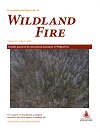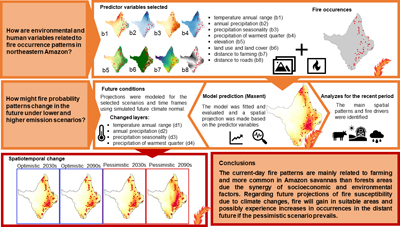
International Journal of Wildland Fire
Volume 32 Number 2 2023
WF22056Using soil moisture information to better understand and predict wildfire danger: a review of recent developments and outstanding questions
 , Kevin O. Achieng, John D. Bolten, J. D. Carlson, Nicholas C. Coops, Zachary A. Holden, Brian I. Magi
, Kevin O. Achieng, John D. Bolten, J. D. Carlson, Nicholas C. Coops, Zachary A. Holden, Brian I. Magi  , Angela J. Rigden and Tyson E. Ochsner
, Angela J. Rigden and Tyson E. Ochsner
Soil moisture is an underused resource for improving fire danger rating systems and fire management worldwide. We review key studies describing relationships between wildfires and in situ, remotely sensed, and modelled soil moisture; describe the potential to incorporate soil moisture into wildfire danger assessments; and identify outstanding challenges and opportunities.
WF22056 Abstract | WF22056 Full Text | WF22056PDF (3.8 MB) Open Access Article
WF21108Relating McArthur fire danger indices to remote sensing derived burned area across Australia
We explored the relationship of the McArthur fire danger classes with the satellite-derived daily burned area The findings suggest that satellite-derived daily burned area may not be a suitable metric for informing McArthur fire danger classes across Australia because it can be subjected to lagged detection.
WF21174Fire propensity in Amazon savannas and rainforest and effects under future climate change

Amazon fire patterns are affected by farming and fires are more common in savanna patches than in forests owing to socioeconomic–environmental factors. By the end of the century, under scenarios with higher emissions, an expansion of fire propensity is expected, resulting in threats to biodiversity, traditional peoples and global human wellbeing.
WF21174 Abstract | WF21174 Full Text | WF21174PDF (2.7 MB) | WF21174Supplementary Material (512 KB) Open Access Article
WF22077A dynamic and evidence-based approach to mapping burn potential
Fire management is a crucial part of managing many environments. We present a burn potential model developed using satellite imagery that predicts when an area may be able to ‘carry’ fire. The model accounts for rapid or delayed vegetation cover response since the last burn due to climate variability.
WF22077 Abstract | WF22077 Full Text | WF22077PDF (3.9 MB) Open Access Article
This work analyses human-caused and natural wildfire behaviour in Galicia (Spain) through non-parametric inference techniques for point processes. Our results show that both spatial and spatiotemporal distribution and dependence structure of fires depend on their cause, suggesting a need for different models to predict arson, negligence and natural fire hazard.
WF22013Coupled fire-atmosphere simulation of the 2018 Camp Fire using WRF-Fire
 , Timothy W. Juliano, Matthew Roberts, Hamed Ebrahimian
, Timothy W. Juliano, Matthew Roberts, Hamed Ebrahimian  , Branko Kosovic, Neil P. Lareau and Ertugrul Taciroglu
, Branko Kosovic, Neil P. Lareau and Ertugrul Taciroglu
Through sensitivity analyses and by comparing with real-world fire perimeters for the 2018 Camp Fire, the performance and challenges of wildland fire simulation with the WRF-Fire simulation platform are investigated.
WF22067The dynamics of burning activity on degraded peatland in two villages in Central Kalimantan, Indonesia
Significant greenhouse gas (GHG) emissions reductions were only achieved with full rewetting. Unconstrained availability of livelihood alternatives will not lead to full rewetting where drained peatland cultivation supports the incumbent livelihood. Livelihood alternatives displacing drained peatland cultivation are essential for sustained reduction in fire risk and GHG emissions.
This study aimed to evaluate how post-fire masticated slash depth affected vegetation regeneration to provide information for forest management planning. The masticated slash depth did not have significant effects on vegetation cover or species diversity 2.5 years after treatments. A lower slash depth favoured pine regeneration.
The LandTrendr model was used to evaluate and categorize the post-fire vegetation change and then combined with Geodetector to analyze the potential driving factors in the Great Xing’An Range of Inner Mongolia. This study will increase understanding of burned vegetation recovery in China.
WF21167 Abstract | WF21167 Full Text | WF21167PDF (4.7 MB) Open Access Article
WF22057Tree spatial pattern and mortality prediction in burned patches of Dahurian larch (Larix gmelinii Rupr.) forest that experienced a mixed-severity wildfire
A larch-dominated forest exhibited density-dependent post-fire mortality patterns at short distances and increased aggregation among surviving trees post-fire. A widely used USA tree mortality model performed acceptably for this species. This study could potentially inform management strategies for conifer forests with similar structures and fire regimes.
The role of live vegetation in altering fire behaviour is increasingly being recognised. To accurately represent the exposure of a live plant to an approaching fire front, a replicable and precise method of testing flammability was developed. It provides a more realistic representation of plant flammability in the natural environment.
This paper presents a statistical analysis of two post-fire building inspection databases of wildland–urban interface (WUI) damage in California and Portugal. Results compare considered building features’ relative correlation to damage, and propose the Wildfire Resistance Index: an index applied to the vulnerability of WUI buildings to wildfire ignition and damage.
WF22095 Abstract | WF22095 Full Text | WF22095PDF (2.2 MB) Open Access Article
WF15048_C1Corrigendum to: Altered mixed-severity fire regime has homogenised montane forests of Jasper National Park
WF22100_COCorrigendum to: Atmospheric turbulent structures and fire sweeps during shrub fires and implications for flaming zone behaviour
WF22100_CO Abstract | WF22100_COPDF (585 KB) Open Access Article



